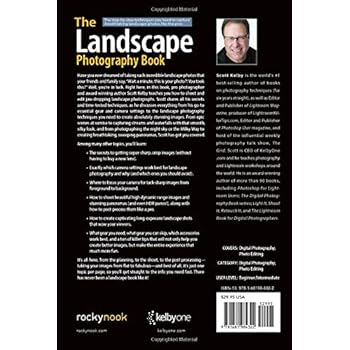The Landscape Photography Book: The step-by-step techniques you need to capture breathtaking landscape photos like the pros
Category: Books,Arts & Photography,Photography & Video
The Landscape Photography Book: The step-by-step techniques you need to capture breathtaking landscape photos like the pros Details
About the Author Scott Kelby is the world’s #1 best-selling author of photography technique books, as well as Editor and Publisher of the highly acclaimed Photoshop User magazine. He is co-host of the influential weekly photography talk show The Grid and he teaches digital photography workshops and seminars around the world. Scott is an award-winning author of over 60 books, including How Do I Do That in Lightroom?, How Do I Do That in Photoshop?, The Lightroom Book for Digital Photographers, The Digital Photography Book series, Professional Portrait Retouching Techniques for Photographers, and Light It, Shoot It, Retouch It. For more on Scott, visit his fantastic blog at scottkelby.com. Read more

Reviews
I love Scott Kelby‘s books, not least because he has a sense of humor, and he writes to be understood. This new book of his is no exception. I love it!I appreciate his advice early on to carry a hood loupe to darken your LCD screen on bright, sunny days. Otherwise, you can’t see what you just shot. He gives a complete discussion of other equipment landscape photographers need to have, including a cable release, polarizer and ND filter, even telling us what type of memory cards to carry and recommending a good backpack. Thank you, Scott!I loved his section on settings for landscape photography because he has one subsection suggesting that the highlight warning is not really accurate - I was quite interested to read that. Turns out that even if you shoot in RAW, your camera shows you the lower quality JPEG which will show more image clipping then there will be on the RAW image — who knew?Although I seldom used live view when shooting wildlife, Kelby is right that you need to use live view for landscape photography. He advises us to zoom in on details on the LCD to make sure everything is tack sharp.I don’t always see, in photography books, a section on how to jump start your creativity before the shoot. Kelby has such a section, and it’s great. He says to start with Pinterest :-). Apparently the website has countless landscapes curated by the various photographers and you can type in your geographical area to see what has been done.He also tells us the usual wisdom about focusing about 1/3 of the way into the shot, but then he gives a tip about alternatively using infinite focus. He says to rotate the focus ring until you reach the infinity symbol but then turn it back a little to right before that symbol. I did not know that.Again, the author often tells us things we think we already knew, like how to use the negative space in composing a photo, but it’s always just a little different angle on things that he gives us. He talks here about the negative space being clean so it does not compete with your real subject off in the corner.I also don’t think I’ve seen a section like he has on not just how to shoot a panoramas but why and when a pano versus wide angle shot. I had never even wondered about this issue so I was grateful to have it set out for me. The main advantage to me seems to be that things maintain their scale in a panorama. He also admonishes us to be quick about shooting panos so that you don’t get blur from moving trees, clouds, etc. Good advice! He has essential chapters on long exposures and shooting the skies because landscape photography so often involves those things. I especially enjoyed the section on how to focus on stars!Toward the end Kelby has what I found to be an extremely useful section on post-processing. He points out some tools I wasn’t aware of in Photoshop, for example the white balance selector tool, that I intend to use tonight! Kelby’s book is full of tips like that. It’s a basic course on Photoshop to some extent and I loved it. I especially enjoyed his piece on how to remove haze in photographs. The author even tells us how to create reflections in landscape photographs.The last two chapters are both useful and fun which is typical of this author. The penultimate chapter gives us miscellaneous tips like why you should carry rain gear, how do defog your lens, creating sun starbursts, and even focus-stacking which I love in my macro work. At the end he gives what he calls “landscape recipes“. Quite useful suggestions: leading lines, mirror-like reflections, foreground elements and the other things we do with landscapes. The fun stuff is he gives camera settings as well as other directions on how to which of these recipes.As I would expect from this very competent author, the book is a complete manual of landscape photography. I don’t need anything else in order to take better landscape photos using his advice. Kelby is also an entertaining writer and he does not write down to us. I would recommend this book to any photographer who wants to get started shooting landscapes.



